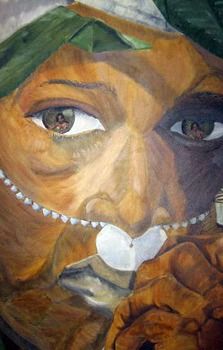Colin McGrath is a storyteller. Each song in his latest CD, “Yellow
Brick Man” captures a moment in life, which he expertly crafts vividly in words
and music. In my recent interview with Colin, he shares the stories behind his
songs, and tells of how his classical background influences his unique style of
folk music.
Faith W: Was there a theme, a motivation, or a message on
this CD?
Colin McGrath: The title song of the album is “Yellow Brick
Man,” and that one has kind of a telling story behind it. One time I was
looking for a bass in a pawnshop on Flatbush Avenue near my house, and I was trying
all these basses out, and this guy comes in, and he’s got a guitar. He walks
in, plops it on the counter, and slides it underneath the bulletproof glass,
and he looks at the guy and says, “Yellow Brick Man, what have you got for me
today?” It was just one of those things that I overheard, and I was like, “Oh
wow, this is cool. What’s this story about? Who is this guy?” He looked like he
was trading in his instrument, trying to see what he could get for it. He made
an impression on me, so I started writing a song from his perspective. It’s about
being at a crossroads in your life, realizing that you need to give up
something in order to get to the next stage. I felt in some way at a similar
crossroads in my life just because in the last three years I’ve become a dad,
and trying to make music and have a family is a challenge.
FW: Congratulations, and congratulations on facing the
realization of the challenge, too. It can be rough; those first few years
especially. Let’s talk a bit more about the theme of the album.
CMcG: Yeah, that crossroads theme comes back in different
ways throughout the album, particularly on songs like “Walls.” And sometimes
you think you are giving up something for good and it actually comes back later
on. There’s a song on the album, “St Anthony’s Return” …
FW: I was going to ask you about that…
CMcG: Yeah; St Anthony is the patron saint of all things
lost. There was a time when I was swimming in this river with my wife and we
hadn’t been married all that long. We were going down this river, and I looked
down at my hand and I realized that I had lost my ring. I was really, really
disappointed, and I was like, “Well, I gotta find this thing.” So it was one of those moments where you’re
like, “this is not a wise decision, I should just forget about it and move on.”
I was just determined to find it though, and somehow when I put my mind to it,
all these events came together and allowed me to get the ring back. I knew that
I needed to find an underwater flashlight so that I could find it, because it
was really dark and the river was really big. I walked down the road, and there
just happened to be a store that sold underwater flashlights. I told the woman at
the store what happened, and she said, “Well, say a prayer to St Anthony, and
maybe he’ll get it back for you.” That’s the first I ever heard about St
Anthony.
So I was saying this little prayer, kind of this little
sing-songy thing, and I was looking into the water with the underwater
flashlight, and lo and behold, there it was. I saw it twinkling there at the bottom
of the river, and after some really strenuous effort, I was able to get the
ring back. It felt like such a huge victory to me.
Sometimes you can intervene with fate and cause extremely
unlikely things to happen. You know, people can disappear from your life for
years and you realize that you really miss them, and then just like that ring,
they will reappear because circumstances align themselves in these crazy ways. The
ring became kind of this symbol for me, of being able to re-connect with
important things that were missing.
FW: Okay. That’s exactly what I got from the song.
CMcG: Oh, really?
FW: Yeah. That’s one of my favorite songs on the CD.
CMcG: Cool.
FW: I also like, “Early Game”.
CMcG: Nice. I feel like that one is the oddball of the
album, really. That one, and maybe “South 2nd Street” are on the
fringe. But those are two of my favorites on it too. I’m glad to hear that they
spoke to you.
FW: Yeah, I like that and “South 2nd Street Serenade”.
The video is just very interesting.
CMcG: That’s my man JP Bouchard. He’s done some great work
with a lot of famous people like Norah Jones, and They Might Be Giants. I felt
very lucky to work with him, he’s an old friend of mine, getting busier and
busier every day. He really liked the South Second Street Serenade, and he was
like, “I’ve got some of these clips that I think would really work with this.”
I’ve watched the video many times, and each time I get something new out of it.
FW: I think that it’s going to be one of those pieces that I
keep coming back to. The two songs, “Early Game” and “South Street Serenade”
are so different than the other songs on the album. How did they end up on the
CD?
CMcG: Well, there are musical/production elements of “Early
Game” and “South Second” on a lot of the other songs. Also, they are both about
escapism somehow, and that relates with the crossroads theme: just wanting to
escape from the weight of big decisions and responsibilities. Take off. Play
the early game.
I also wanted the end of the album to go into a wordless
space. When “Early Game” hits, I feel that there is a kind of launching that
happens. I write a lot of instrumental music, and sometimes I don’t like to
have any words at all. Just music.
FW: Sometimes you don’t need the words. You know, I actually
wanted to thank you because in listening to your CD and reading your bio I was inspired
to break out the String Quartet in F Major by Ravel that I had not heard in
many, many years.
CMcG: Oh yeah? You’re a fan of that stuff?
FW: Yeah!
CMcG: Cool! I’m thinking about Le Tombeau de Couperin.
Michael Holt from The Mommyheads performed that at a show I saw recently and it just totally blew me away. I
remember in college one of my housemates was an amazing piano player and he
would play that piece, and I would just lie down, sometimes underneath the
piano and just float away.
FW: Yes, Ravel’s work can cause you to do that. And I want
to thank you for reminding me because I haven’t had the opportunity to listen
to classical music in some time because I’ve been listening to so many other
things. I can see glimpses of your musical influences here and there, and it
melds well within your work.
CMcG: Thank you.
FW: You’re welcome. I have a question, and it may seem a
little weird, but I’m going to go with it. I’m going to give you a choice of
several words to describe your songwriting, and I want you to pick one and tell
me why you picked it. The words are: snapshot, sketch, and painting.
McG: Well, my album “Window Seat,” was more of a snapshot.
It was about making observations and taking pictures of things that were going
on outside of myself. “Yellow Brick Man,” is more like a painting. I say that
because it’s taken a long time to give birth to this album, and there are so
many layers on it. It’s a little bit like one of those old paintings where
somebody’s head has been painted in two different directions and if you dig
deep enough behind those layers of paint, you’ll see that the picture looked
entirely different. These songs are like that; they’ve gone through lots of
changes and lots of revisions.
FW: What’s in the future? What are you working on?
CMcG: I have a friend who sings a lot of the harmony on the
album, his name is Jason Harrod. He used to be in a pretty well known duet called Harrod and Funck, and
we’re actually working on some hymns. There’s something that I’ve always really
liked about hymns; the way the harmonies move, the lyrics are heartfelt and
innocent in a way. And I’m not a particularly religious person myself, though I
definitely think a lot about spirituality. For some reason when I hear hymns it
kind of connects me with the place that I’d like to go spiritually. So we’re
working on that. And I’ve got a bunch of instrumental stuff that I’d like to
put out too.
FW: I’d like to hear that. You have such a diverse musical
background, and it really shines through.
CMcG: Thanks Faith, it’s been a pleasure talking with you!







